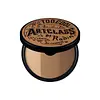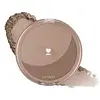What's inside
What's inside
 Key Ingredients
Key Ingredients

 Benefits
Benefits

 Concerns
Concerns

 Ingredients Side-by-side
Ingredients Side-by-side

Talc
AbrasiveMica
Cosmetic ColorantPentaerythrityl Tetraethylhexanoate
EmollientMagnesium Stearate
Cosmetic ColorantNylon-12
Titanium Dioxide
Cosmetic ColorantDiisostearyl Malate
EmollientCI 77492
Cosmetic ColorantCI 77491
Cosmetic ColorantAminopropyl Dimethicone
Polymethylsilsesquioxane
CI 77499
Cosmetic ColorantMethylparaben
PreservativeAlumina
AbrasivePropylparaben
PreservativeCeria/Silica Talc
UV AbsorberSilica
AbrasiveTalc
AbrasivePolyethylene
AbrasiveNylon-12
Phenyl Trimethicone
Skin ConditioningCI 77492
Cosmetic ColorantSilica
AbrasiveMagnesium Myristate
CI 77499
Cosmetic ColorantCI 77491
Cosmetic ColorantCI 77891
Cosmetic ColorantDiisostearyl Malate
EmollientCaprylic/Capric Triglyceride
MaskingCaprylyl Glycol
EmollientEthylhexylglycerin
Skin ConditioningPolymethylsilsesquioxane
Methicone
EmollientDimethicone
EmollientTriethoxycaprylylsilane
Synthetic Fluorphlogopite
Tocopherol
AntioxidantTalc, Polyethylene, Nylon-12, Phenyl Trimethicone, CI 77492, Silica, Magnesium Myristate, CI 77499, CI 77491, CI 77891, Diisostearyl Malate, Caprylic/Capric Triglyceride, Caprylyl Glycol, Ethylhexylglycerin, Polymethylsilsesquioxane, Methicone, Dimethicone, Triethoxycaprylylsilane, Synthetic Fluorphlogopite, Tocopherol
 Reviews
Reviews

Ingredients Explained
These ingredients are found in both products.
Ingredients higher up in an ingredient list are typically present in a larger amount.
Ci 77491 is also hydrated iron III oxide. It's sole purpose is to give a red/pink hue to products.
Iron III oxides are classified as inorganic chemicals for coloring.
Synthetically created Ci 77491 is considered safer than those naturally found. This is because the synthetically created version may contain less impurities. Iron oxides are generally non-toxic and non-allergenic.
Learn more about CI 77491Ci 77492 is also hydrated iron III oxide. It's sole purpose is to give a yellow hue to products.
Iron III oxides are classified as inorganic chemicals for coloring.
Synthetically created Ci 77492 is considered safer than those naturally found. This is because the synthetically created version may contain less impurities. Iron oxides are generally non-toxic and non-allergenic.
Learn more about CI 77492Ci 77499 is also hydrated iron III oxide. It is created from mixing red and black iron oxides. This helps give shades of darkness to a product.
Iron III oxides are classified as inorganic chemicals for coloring.
Diisostearyl Malate is an emollient and most often used in lip products. It comes from isostearyl alcohol, a fatty acid, and malic acid, an AHA.
As an emollient, Diisostearyl Malate helps create a thin film on your skin to trap moisture in. This helps keep your skin soft and smooth.
Nylon-12 is a polymer. It is derived from 12-aminododecanoic acid, an omega-amino fatty acid
According to a manufacturer, it is a talc substitute. Like talc, nylon-12 gives products a satin feel. The manufacturer also claims this ingredients does not block pores and has moderate oil absorption.
This ingredient may not be reef-safe.
Learn more about Nylon-12Polymethylsilsesquioxane is a silicone used as a film forming agent.
When applied to the skin, this ingredient creates an invisible film on the surface. This film still allows oxygen to pass through, but prevents moisture from escaping. This can help condition and hydrate the skin. It also leaves a silky feel when applied.
Polymethylsilsesquioxane has not been shown to clog pores. It has been deemed safe to use up to 55%, but most cosmetics use much less.
If you have concerns about using this ingredient, we recommend speaking with a professional.
Learn more about PolymethylsilsesquioxaneSilica, also known as silicon dioxide, is a naturally occurring mineral. It is used as a fine, spherical, and porous powder in cosmetics.
Though it has exfoliant properties, the function of silica varies depending on the product.
The unique structure of silica enhances the spreadability and adds smoothness, making it a great texture enhancer.
It is also used as an active carrier, emulsifier, and mattifier due to its ability to absorb excess oil.
In some products, tiny microneedles called spicules are made from silica or hydrolyzed sponge. When you rub them in, they lightly polish away dead skin layers and enhance the penetration of active ingredients.
Learn more about SilicaTalc is a clay mineral. It helps absorb moisture and improve the texture of products. Like other types of clay, Talc can have a slight exfoliating effect on skin. Talc can be added to increase the volume of products.
Some Baby powders are made by combining talc with corn starch. The word "talc" comes from Latin and originates from Arabic. Talc is a mineral commonly found throughout the world.
If you have any concerns about using talc, we recommend checking out the FDA's official page.
Learn more about Talc